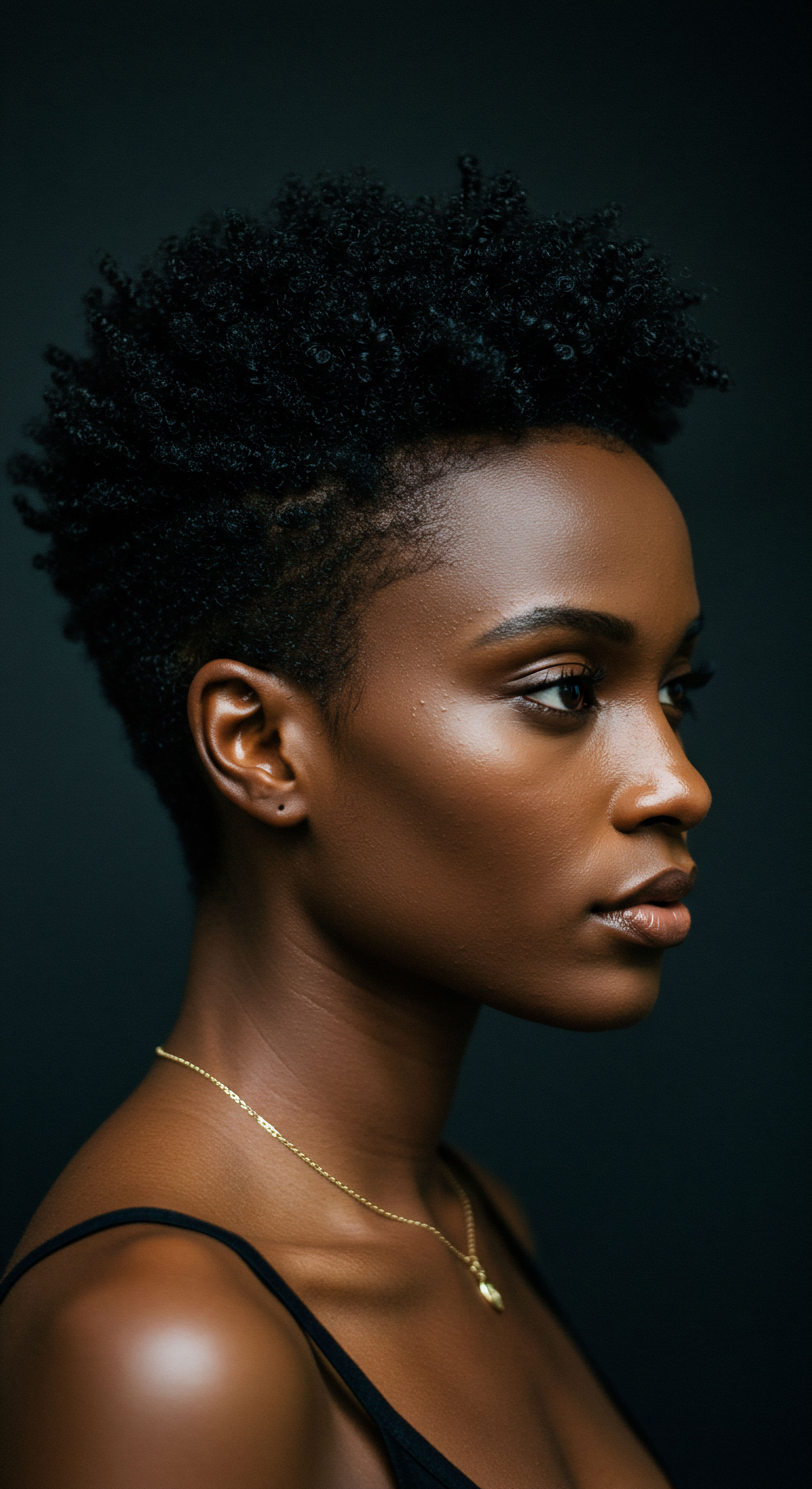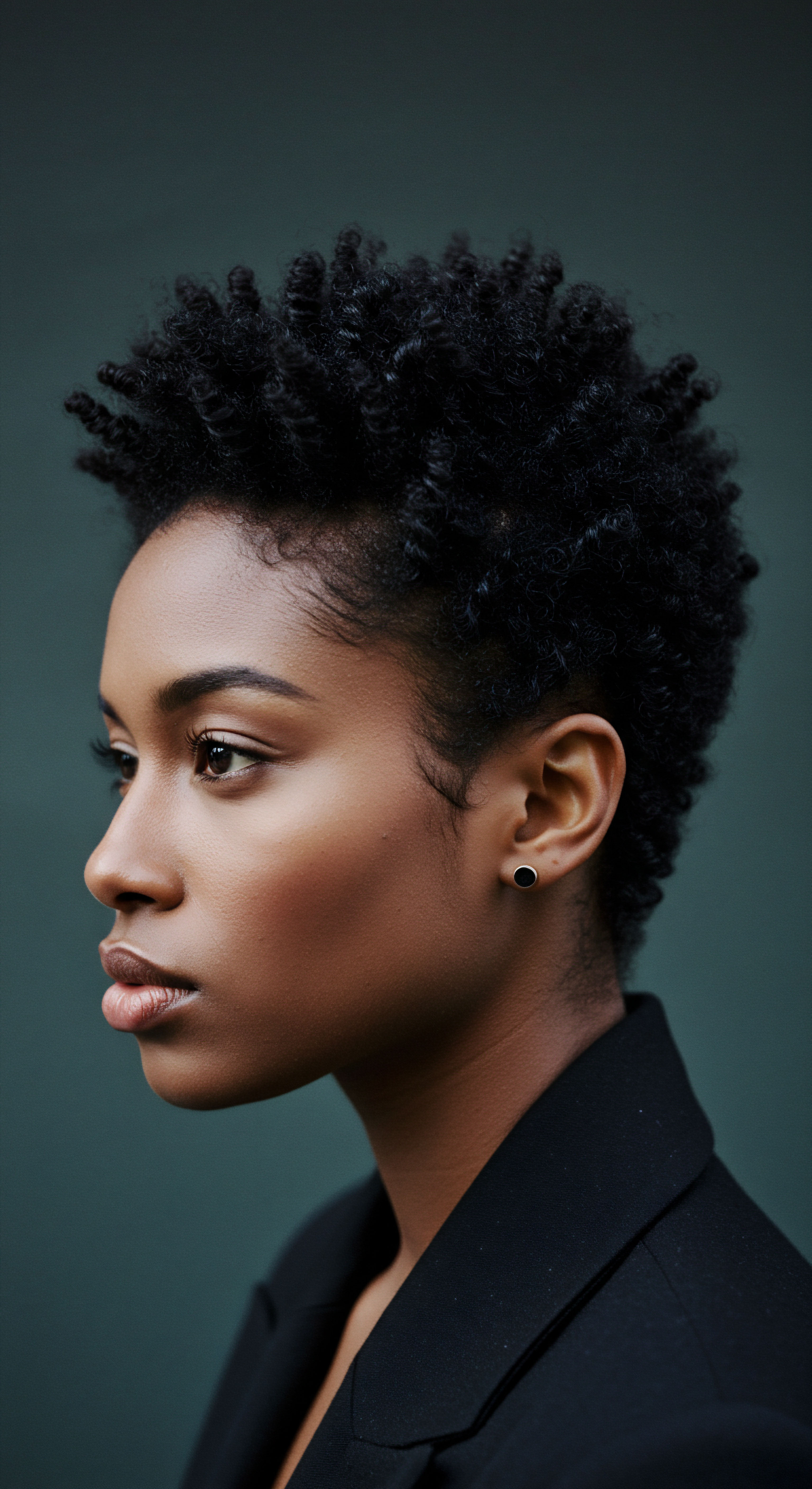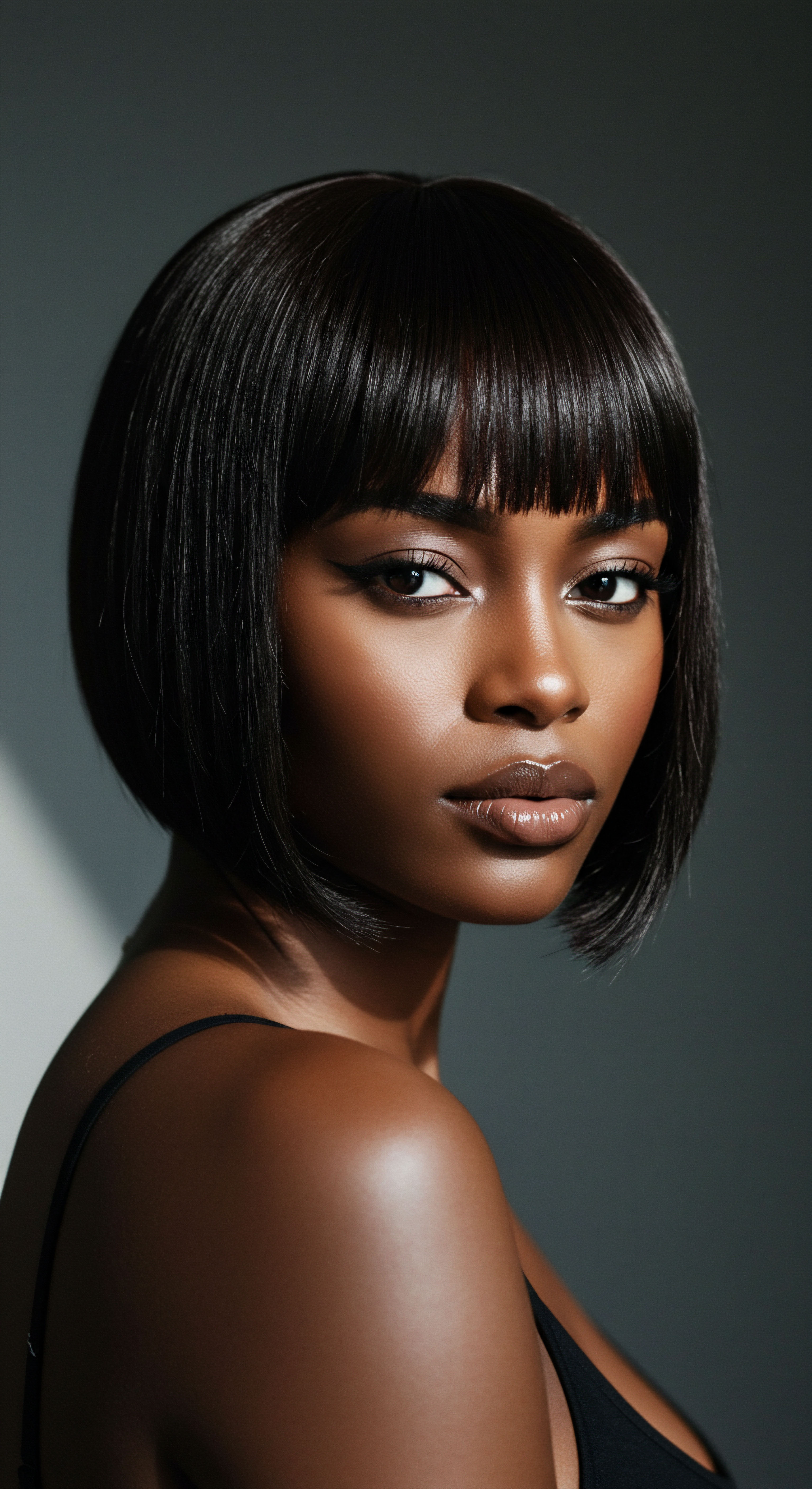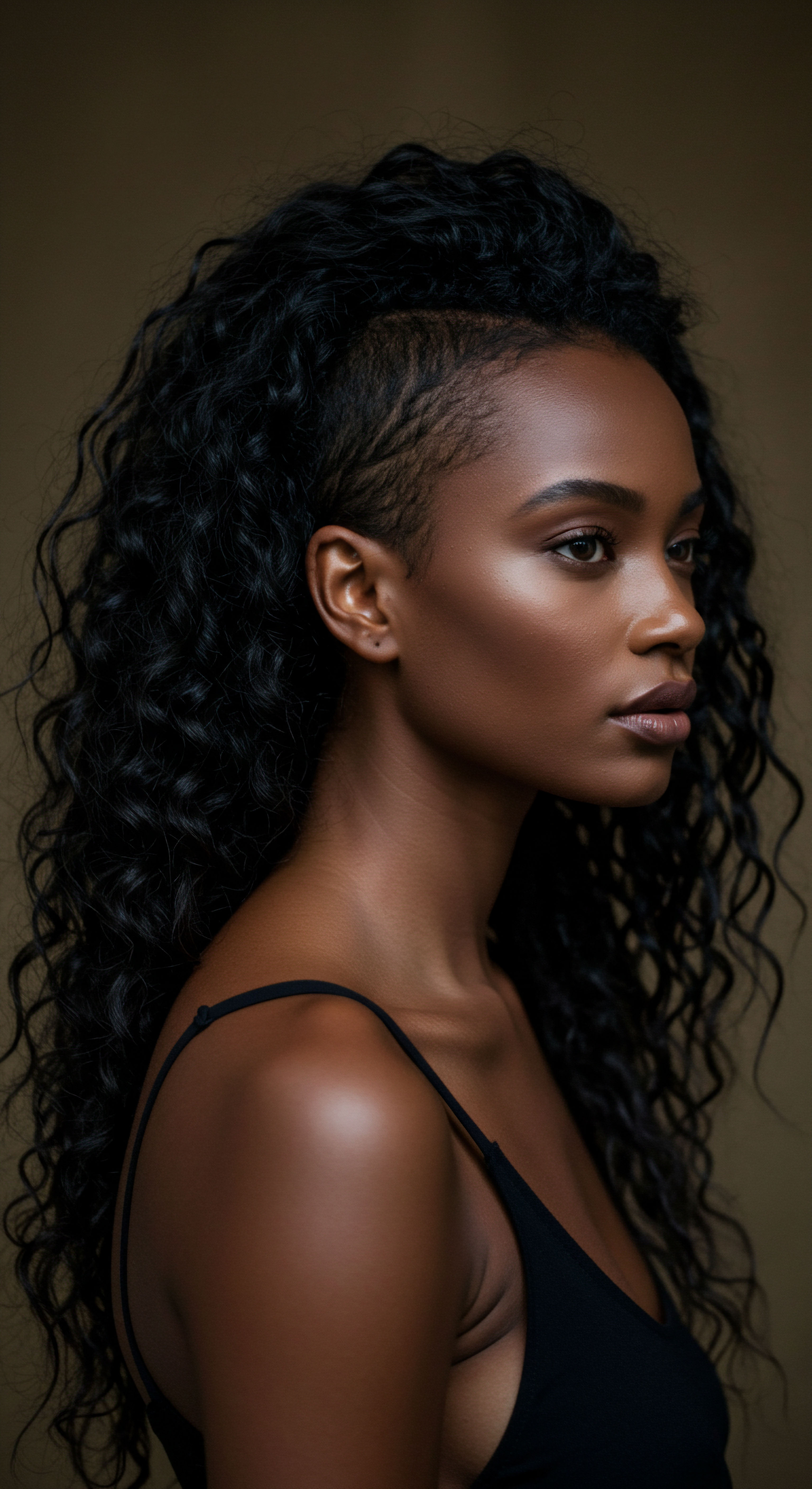
Roots
To truly understand the whisper of sleep upon textured hair, we must first return to the elemental, to the very origins of each strand and the rhythmic pulse that guides its existence. This is not a casual glance at a daily routine, but an invitation to witness the profound interplay between our deepest rest and the vitality of our crown. Consider the delicate architecture of a single curl, the inherent strength and vulnerability that define it. This understanding forms the groundwork for recognizing how something as seemingly passive as sleep holds sway over its growth and well-being.

Hair Anatomy Specific to Textured Hair
The unique beauty of textured hair stems from its distinctive anatomical structure. Unlike straight hair, which typically emerges from a round follicle, textured strands often originate from an Elliptical or S-Shaped Follicle, causing the hair shaft to grow with a natural curl or coil. This shape dictates the varying diameters along the hair fiber and the points of curvature, rendering textured hair more susceptible to mechanical damage than its straighter counterparts. The cuticle, the outermost protective layer, tends to be more open or lifted in textured hair, which, while allowing for greater absorption of moisture, also means a quicker release of it, leading to a propensity for dryness.
Beneath the cuticle lies the cortex, the primary component of the hair shaft, responsible for its strength, elasticity, and color. Within the cortex, the arrangement of keratin proteins and disulfide bonds plays a significant role in defining the curl pattern and overall resilience. Textured hair often possesses a higher number of disulfide bonds compared to European hair, contributing to its unique morphology and elasticity. The innermost layer, the medulla, while not always present in all hair types, also contributes to the strand’s overall structure.

Textured Hair Classification Systems
The rich diversity of textured hair has given rise to various classification systems, each attempting to categorize the myriad curl patterns observed. While systems like Andre Walker’s numerical and alphabetical types (e.g. 3A, 4C) are widely known for their simplicity, they sometimes fall short in capturing the full spectrum of variations and often oversimplify the complex interplay of factors that define a hair type. Other systems, such as LOIS (L for Luster, O for Originality, I for Consistency, S for Sheen) or FGI (Curl Pattern, Density, Strand Thickness, Porosity), offer a more comprehensive approach, acknowledging that hair is more than just its curl pattern.
These systems consider aspects like strand thickness, density, and porosity, providing a more holistic understanding of a person’s hair characteristics. A deeper comprehension of these classifications aids in tailoring appropriate care, moving beyond superficial labels to address the intrinsic needs of each unique hair type.
Understanding the distinct anatomy and varied classification systems of textured hair lays the foundation for appreciating its unique care requirements.

The Essential Lexicon of Textured Hair
Navigating the world of textured hair care calls for a precise vocabulary. Certain terms hold particular weight in discussions of textured hair health:
- Porosity ❉ This refers to your hair’s ability to absorb and hold moisture. High porosity hair, with its more open cuticle, absorbs moisture quickly but loses it just as fast. Low porosity hair, with a tightly closed cuticle, resists moisture absorption but retains it well once hydrated.
- Elasticity ❉ This is the hair’s ability to stretch and return to its original state without breaking. Healthy elasticity indicates strong, well-hydrated hair.
- Density ❉ This describes the number of individual hair strands on your scalp. Hair can be fine, medium, or coarse in thickness, irrespective of its density.
- Shed Versus Breakage ❉ It is important to distinguish between normal hair shedding, which is part of the natural growth cycle, and breakage, which indicates damage to the hair shaft. Understanding this distinction helps identify underlying issues.
These terms provide a framework for discerning the specific needs of textured hair, allowing for a more targeted and effective approach to care.

Hair Growth Cycles and Influencing Factors
Hair growth is a cyclical process, a rhythmic dance orchestrated by our biology. Each hair follicle undergoes three main phases:
- Anagen ❉ The active growth phase, where hair cells divide rapidly, forming new hair. This phase can last for several years, determining the ultimate length of the hair.
- Catagen ❉ A short transitional phase where hair growth slows, and the follicle begins to shrink.
- Telogen ❉ The resting phase, where the hair stops growing and eventually sheds to make way for new growth.
This cycle is influenced by a multitude of factors, both internal and external. Hormones, nutrition, stress levels, genetics, and environmental exposures all play a part in regulating the length and health of each phase. Understanding these foundational elements provides the context for exploring how something as seemingly simple as sleep consistency can exert such a profound influence on the life cycle of textured hair.

Ritual
Stepping from the foundational understanding of textured hair, we now turn our gaze toward the daily and nightly practices that shape its vitality. The quest for healthy textured hair is often viewed through the lens of products and styling techniques, yet a deeper wisdom reveals that true well-being stems from consistent, thoughtful rituals. How do we tend to our strands with intention, especially as the day fades and the world settles into slumber? This section invites us to consider the quiet, yet potent, power of mindful care, particularly as it relates to the transformative period of sleep.

Building Personalized Textured Hair Regimens
A flourishing head of textured hair often relies upon a regimen tailored to its unique characteristics. This is not a one-size-fits-all proposition, but a personalized approach that respects the individual needs of each curl, coil, or wave. A thoughtful regimen typically involves several core steps:
- Cleansing ❉ Regular, gentle cleansing removes product buildup and environmental impurities without stripping the hair of its natural oils. Selecting sulfate-free cleansers designed for textured hair helps maintain its delicate moisture balance.
- Conditioning ❉ Deep conditioning is a cornerstone of textured hair care. Conditioners help to smooth the cuticle, reduce tangles, and impart much-needed moisture. Incorporating leave-in conditioners can provide continuous hydration throughout the day.
- Moisturizing ❉ Given textured hair’s tendency towards dryness, consistent moisturizing is paramount. Water-based products, followed by heavier creams or butters, can help to seal in hydration.
- Sealing ❉ The final step often involves applying an oil or butter to seal the moisture into the hair shaft, providing a protective barrier against environmental stressors.
The rhythm of these steps, adapted to one’s specific hair porosity and density, creates a supportive environment for healthy growth.

The Nighttime Sanctuary Essential Sleep Protection and Bonnet Wisdom
As daylight recedes, our bodies enter a phase of rest and repair, and our hair, too, seeks refuge. The nighttime hours, if left untended, can become a source of friction and moisture loss for textured strands. This is where the wisdom of sleep protection, particularly the use of bonnets and silk pillowcases, becomes invaluable.
Friction from cotton pillowcases can lead to tangles, breakage, and the disruption of the hair’s delicate cuticle layer. Cotton fibers absorb moisture, drawing essential hydration away from the hair and contributing to dryness. A smooth, non-absorbent surface provides a gentle haven for textured hair.
Bonnets, typically made of satin or silk, create a protective barrier, reducing friction against bedding and preserving the hair’s moisture content. They help to keep curl patterns intact, minimize tangles, and reduce the need for excessive manipulation in the morning. Similarly, Silk Pillowcases offer a smooth glide, lessening friction and helping to maintain hydration for those who prefer not to cover their hair. This simple ritual transforms the sleeping space into a sanctuary for strands, allowing them to retain their natural oils and moisture.
Nighttime hair rituals, particularly the use of silk or satin protection, play a quiet but powerful role in preserving moisture and preventing damage to textured hair.

Ingredient Deep Dives for Textured Hair Needs
Understanding the ingredients in our hair products is akin to knowing the nourishing elements of a well-prepared meal. For textured hair, certain ingredients offer particular benefits:
- Humectants ❉ Substances like glycerin, hyaluronic acid, and aloe vera draw moisture from the air into the hair, providing hydration. They are particularly beneficial in humid climates.
- Emollients ❉ Oils (like jojoba, argan, coconut) and butters (shea, cocoa) smooth the hair surface, reduce friction, and provide a protective film, sealing in moisture.
- Proteins ❉ Hydrolyzed wheat protein, keratin, and silk amino acids can temporarily strengthen the hair shaft and reduce breakage, especially for hair that has experienced damage. However, too much protein can lead to stiffness, so balance is key.
Conversely, certain ingredients might be less suitable. Sulfates, harsh alcohols, and heavy silicones (unless water-soluble) can strip natural oils or cause buildup, hindering moisture penetration. A discerning eye for ingredient lists empowers one to make choices that truly serve the hair’s well-being.

Textured Hair Problem Solving Compendium
Even with the most diligent rituals, textured hair can present its own set of challenges. Addressing these concerns with gentle wisdom and informed solutions is central to a journey of hair wellness.
Dryness remains a common concern, often mitigated by consistent moisturizing practices, layering of products, and protective styling. When hair feels persistently parched, reviewing the frequency of deep conditioning and ensuring adequate water intake can provide relief.
Breakage, signaled by short pieces of hair, split ends, or excessive shedding, often points to mechanical stress or a lack of protein/moisture balance. Minimizing manipulation, gentle detangling, and protective styles become vital.
Scalp Health forms the bedrock of healthy hair growth. An irritated or dry scalp can impede the follicle’s ability to produce strong strands. Regular, gentle cleansing and targeted scalp treatments can address issues like flakiness or itchiness.
Tangles, a frequent companion of textured hair, are best managed with patience and proper tools. Wide-tooth combs and fingers, coupled with ample conditioner, allow for gentle unraveling, preventing unnecessary strain on the strands. Each challenge, when met with understanding and a commitment to mindful care, becomes an opportunity for deeper connection with one’s hair.

Relay
How does the rhythmic pulse of our nightly slumber truly resonate within the delicate structures of textured hair? To answer this, we must journey beyond the visible, delving into the intricate cellular dance and the subtle hormonal symphony that sleep conducts. This is where the profound interconnectedness of our body’s systems comes into focus, revealing that sleep consistency is not merely a matter of rest, but a powerful determinant of hair’s very vitality, its resilience, and its capacity for sustained growth.

The Chronobiology of Hair Circadian Rhythms and Follicle Activity
Our bodies operate on a finely tuned internal clock, the circadian rhythm, which governs a vast array of physiological processes, from hormone secretion to cell division. This 24-hour cycle is deeply influential, extending its reach even to the hair follicles. Research indicates that hair follicles themselves possess their own peripheral circadian clocks, synchronized with the body’s central rhythm. These follicular clocks regulate gene expression and cell activity, impacting the hair growth cycle’s progression.
For instance, studies on mice have shown that core circadian clock genes, such as Clock and Bmal1, play a significant role in regulating the hair follicle cycle. Disruptions to these genes can lead to a delay in the anagen (growth) phase, affecting overall hair growth. This suggests that when our sleep patterns become erratic, the internal timing of our hair follicles may also be thrown off balance, potentially hindering their optimal function and growth capacity. The precise orchestration of these internal rhythms is a quiet, yet powerful, force in maintaining hair health.

Beyond the Pillow Systemic Influences of Sleep Deprivation on Hair Health
The impact of inconsistent sleep stretches far beyond superficial signs of fatigue, permeating the body’s core systems and directly influencing hair health. This systemic disruption is a critical, often overlooked, aspect of textured hair wellness.

Stress Hormones and Hair Loss
One of the most immediate consequences of sleep deprivation is the elevation of Cortisol, often termed the “stress hormone”. Chronic, elevated cortisol levels are directly linked to a condition known as telogen effluvium, where a higher percentage of hair follicles prematurely enter the resting (telogen) phase, leading to increased shedding and noticeable thinning. A Harvard study revealed that sustained high cortisol levels can actually impede the regeneration of hair follicle stem cells, trapping them in a prolonged resting state and making it harder for the body to replace lost hair over time. This underscores a significant, science-backed data point ❉ a single night of sleep deprivation can trigger measurable cellular damage, with oxidative stress acting as a central mechanism.
Consider the findings from a study published in the Journal of Pineal Research, which explored the effects of Sleep Restriction (SR) on skin barrier function in mice. This 28-day model, simulating continuous long-term sleep loss, revealed that SR not only damaged the skin’s barrier function and caused oxidative stress, but also weakened the oscillations of the skin’s biological clock and disrupted the circadian rhythm of beneficial gut bacteria like Bacteroides. Crucially, melatonin supplementation was found to improve skin damage by restoring the circadian rhythm of Bacteroides and its propionic acid metabolite, which in turn improved keratinocyte barrier function.
While this study primarily focused on skin, the interconnectedness of skin and scalp health, and the presence of melatonin receptors in hair follicles, suggests a similar mechanism at play for hair growth and resilience. This highlights a compelling, perhaps controversial, idea ❉ the quality of your sleep, mediated by melatonin and even your gut microbiome, directly influences the protective integrity of your scalp and, by extension, the health of your hair.

Inflammation and Nutrient Absorption
Sleep deprivation can also ignite systemic inflammation, creating an environment hostile to healthy hair growth. This inflammatory state can negatively impact hair follicles, potentially contributing to various scalp conditions and impeding their ability to function optimally. Furthermore, inconsistent sleep can compromise the body’s ability to absorb and utilize essential nutrients crucial for hair production.
Hair follicles are among the fastest-growing tissues in the body and demand a steady supply of vitamins, minerals, and proteins, delivered through robust blood circulation. When sleep is inadequate, blood flow to the scalp can be restricted, depriving follicles of these vital building blocks, leading to weaker, slower-growing strands.
| Hormone Melatonin |
| Role in Hair Growth Regulates sleep-wake cycles; acts as an antioxidant; can extend hair growth phase. |
| Impact of Inconsistent Sleep Reduced production, potentially shortening the active growth phase and weakening antioxidant defense. |
| Hormone Human Growth Hormone (HGH) |
| Role in Hair Growth Essential for cell regeneration, tissue repair, and protein synthesis; surges during deep sleep. |
| Impact of Inconsistent Sleep Decreased levels due to insufficient deep sleep, leading to slower growth and weaker strands. |
| Hormone Cortisol |
| Role in Hair Growth Stress hormone; high levels can disrupt hair growth cycle. |
| Impact of Inconsistent Sleep Elevated levels, pushing follicles into resting phase prematurely and contributing to shedding. |
| Hormone Maintaining sleep consistency supports a balanced hormonal environment conducive to hair vitality. |

Cultural Echoes of Rest and Hair Wellness
The connection between rest and hair wellness extends beyond the purely biological, echoing through cultural practices and ancestral wisdom. Across diverse traditions, hair has often been revered as a symbol of strength, identity, and spiritual connection. Many cultures have long held practices that prioritize rest and specific nighttime rituals for hair care, intuitively understanding the restorative power of slumber.
From elaborate braiding patterns that protect strands overnight to the use of natural oils and coverings before sleep, these practices often speak to a deep respect for the hair’s vulnerability during periods of inactivity. While not always framed in scientific terms, these traditions often align with modern understanding of moisture retention and friction reduction. The cultural emphasis on holistic well-being, where mind, body, and spirit are seen as interconnected, naturally extends to the care of hair, recognizing that true vibrancy stems from a state of internal balance and peace. The quiet act of preparing one’s hair for sleep, whether through a simple wrap or a more elaborate ritual, becomes a continuation of a heritage that understands the value of rest for beauty and vitality.
The profound impact of sleep consistency on hair growth extends to its cellular chronobiology and hormonal regulation, underscoring rest as a fundamental biological requirement for vibrant strands.

The Scientific Scrutiny of Sleep and Dermal Health
The scientific community continues to uncover the depth of sleep’s influence on dermal health, a realm that intimately includes the scalp and, by extension, hair follicles. Research consistently points to sleep as a critical period for skin cell regeneration and repair. During deep sleep, the body’s natural repair mechanisms are at their most active, working to reverse daily damage from environmental stressors like UV exposure and pollution.
A significant decrease in skin hydration and impaired barrier function have been observed after even a single night of sleep deprivation. This diminished barrier function makes the skin, including the scalp, more vulnerable to external factors and contributes to increased transepidermal water loss (TEWL), leading to dryness. Since the scalp is the foundation for hair growth, a compromised scalp barrier directly affects the environment in which hair follicles reside, potentially impeding their ability to produce healthy hair.
Moreover, studies have shown that poor sleep can lead to increased oxidative stress, an imbalance between free radicals and the body’s ability to counteract their harmful effects. Oxidative stress can damage hair follicles, contributing to hair loss and overall poor hair health. The interplay between sleep, oxidative stress, and the skin barrier function highlights the profound, interconnected ways in which consistent, restorative sleep serves as a silent, yet powerful, ally in the quest for vibrant, resilient textured hair.

Reflection
As the quietude of night descends, carrying with it the promise of renewal, so too does the opportunity for our textured strands to find their deepest restoration. We have journeyed through the intricate anatomy of a curl, traced the rhythms of ancient rituals, and explored the subtle scientific orchestrations that unfold within us as we rest. The consistency of our sleep, it becomes clear, is not a mere luxury, but a profound act of care, a silent dedication to the vibrancy that resides within each hair follicle.
It is a testament to the idea that true beauty stems from a state of balance, a gentle harmony between our inner world and the external expressions of our well-being. May this understanding deepen your connection to your hair, inspiring a quiet reverence for the nightly return to self.

References
- Biddle-Perry, G. & Harlow, M. (Eds.). (2019). A Cultural History of Hair ❉ Volumes 1-6. Bloomsbury Academic.
- McMullen, R. L. & Popescu, L. (2022). Physicochemical Properties of Textured Hair. Journal of Cosmetic Science, 72, 711-731.
- Paus, R. & Cotsarelis, G. (2003). The Biology of Hair Follicles. New England Journal of Medicine, 348(12), 1014-1024.
- Lin, K. K. et al. (2009). Circadian Clock Genes Contribute to the Regulation of Hair Follicle Cycling. PLoS Genetics, 5(6), e1000513.
- Slominski, A. T. et al. (2005). Melatonin and the Hair Follicle. Journal of Pineal Research, 38(1), 1-13.
- Tobin, D. J. (2018). Hair Growth & Disorders. CRC Press.
- Randall, V. A. (2003). The Endocrine Control of the Hair Follicle. Clinical Dermatology, 21(4), 287-292.
- Hardman, J. G. et al. (Eds.). (2001). Goodman & Gilman’s The Pharmacological Basis of Therapeutics (10th ed.). McGraw-Hill.
- Oh, H. J. et al. (2014). The Effects of Sleep Deprivation on the Biophysical Properties of Facial Skin. Journal of the American Academy of Dermatology, 71(1), AB42.
- Chen, H. et al. (2023). Melatonin improves skin barrier damage caused by sleep restriction through gut microbiota. Journal of Pineal Research, 75(1), e12874.
- Robinson, S. T. (2023). So You Think You Want To Be A Trichologist ❉ Unlocking The Secrets of Hair ❉ A journey into the world of Trichology. Self-published.
- Snook, E. (Ed.). (2021). A Cultural History of Hair in the Renaissance. Bloomsbury Academic.
- Lin, C. Y. & Chen, Y. C. (2023). Melatonin-Mediated Circadian Rhythm Signaling Exhibits Bidirectional Regulatory Effects on the State of Hair Follicle Stem Cells. International Journal of Molecular Sciences, 24(17), 13303.
- Song, Y. et al. (2023). Melatonin’s Role in Hair Follicle Growth and Development ❉ A Cashmere Goat Perspective. Animals, 13(14), 2278.
- Trüeb, R. M. (2015). Oxidative Stress in Ageing of Hair. International Journal of Trichology, 7(1), 6-10.